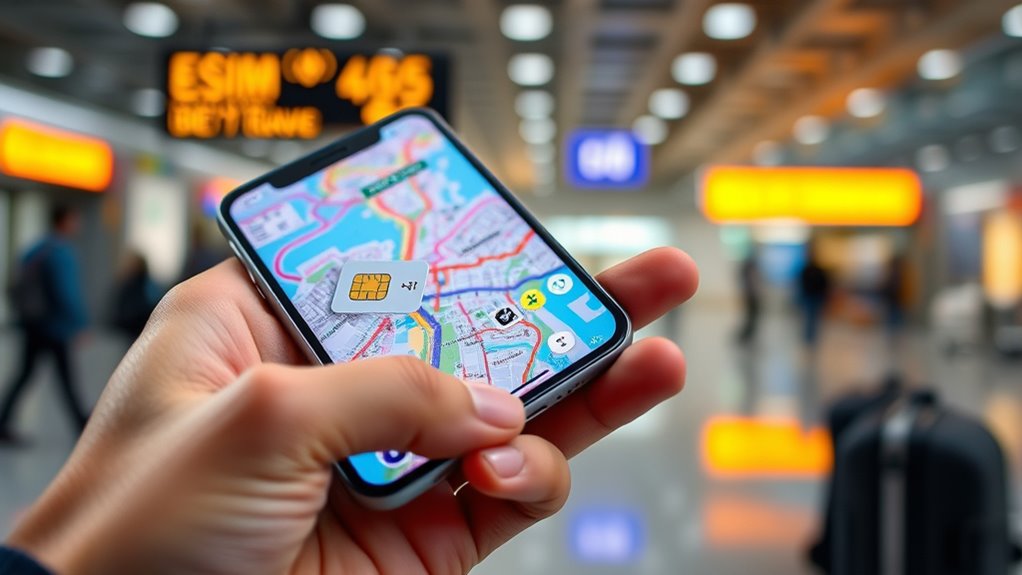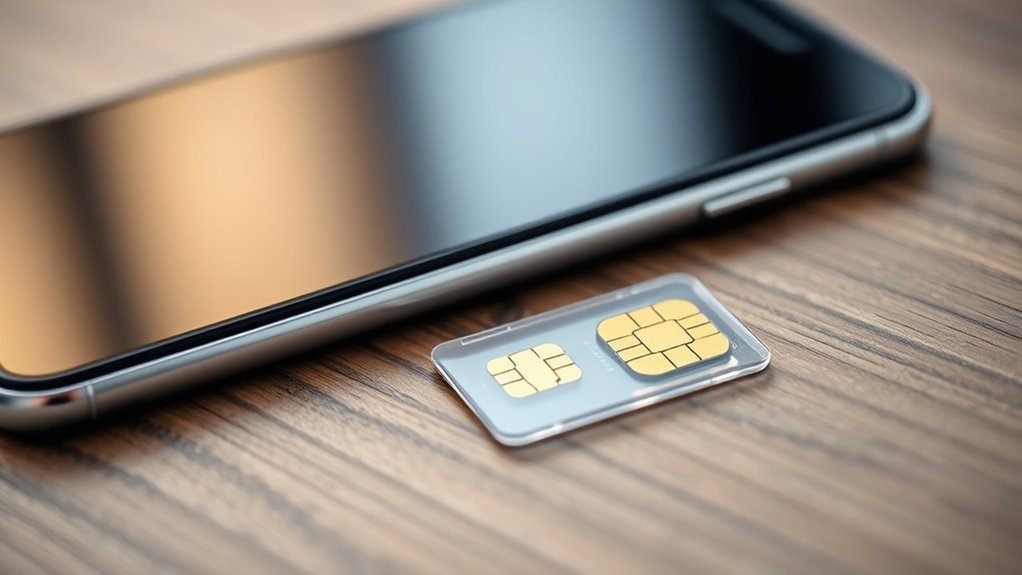If you’re a traveler, an eSIM offers quick activation, easy switching between plans, and fewer worries about physical damage or loss. It’s embedded into your device, making it more durable and convenient, especially for multi-region trips. A physical SIM is still reliable and might be better if your device doesn’t support eSIMs. To discover the key differences and find the best fit for your journeys, keep exploring these options further.
Key Takeaways
- eSIMs enable quick, digital activation and switching between plans, ideal for frequent travelers.
- Physical SIMs are more vulnerable to damage and theft but may be necessary where eSIM support is limited.
- eSIMs support multiple profiles, simplifying multi-region travel and avoiding physical SIM swaps.
- Physical SIMs require manual insertion and handling, which can be inconvenient during international trips.
- eSIMs offer enhanced durability, security, and convenience, making them the preferred choice for modern travelers.

With the rise of digital technology, eSIMs are quickly transforming how we connect to mobile networks, offering a modern alternative to traditional physical SIM cards. If you’re a traveler, this shift can substantially impact your experience, especially when it comes to eSIM activation and the durability of physical SIMs. Unlike physical SIM cards that require you to insert a tiny chip into your device, eSIMs are embedded directly into your phone’s hardware. This means you don’t need to handle tiny cards or visit stores to swap SIMs when changing carriers or traveling internationally. Instead, eSIM activation happens digitally, often within minutes, through a simple QR code scan or an app. This convenience saves you time and reduces the hassle of managing multiple SIM cards for various regions. Additionally, eSIMs support multiple profiles, allowing you to store and switch between different plans easily, which is especially useful for frequent travelers.
Physical SIM cards, on the other hand, are known for their durability. They can withstand some wear and tear, but they are still prone to damage if mishandled. A bent or scratched SIM can cause connectivity issues, forcing you to replace it altogether. For travelers, this can be inconvenient, especially in remote locations where replacements aren’t readily available. The physical nature of these SIMs also means they’re more susceptible to loss or theft, which could compromise your mobile service or personal data.
Frequently Asked Questions
Can I Switch Between Esim and Physical SIM on the Same Device?
You can switch between eSIM and physical SIM on your device if it supports both, but check device compatibility first. Some phones allow easy toggling through settings, while carrier restrictions might limit this option. Make sure your carrier permits such switches, as some carriers lock their SIMs or limit eSIM activation. If compatible, switching is straightforward—just follow your device’s instructions to change your active SIM.
Are Esims Compatible With All Mobile Carriers Worldwide?
You might wonder if eSIMs work with all mobile carriers worldwide. While eSIM compatibility has grown, carrier compatibility varies, and not all providers support eSIMs yet. For global coverage and seamless service, check if your carrier offers eSIM support in your travel destinations. Confirming carrier compatibility before you travel guarantees you can activate your eSIM without issues, giving you flexible, hassle-free connectivity wherever you go.
How Secure Is an Esim Compared to a Physical SIM?
You might wonder about eSIM security compared to physical SIMs. Generally, eSIMs are quite secure because they use advanced data encryption and remote management, reducing physical theft risk. However, security concerns like hacking or unauthorized access remain, just like with physical SIMs. Overall, both options are safe if you follow best practices, but eSIMs’ digital nature offers some advantages in managing security remotely.
What Are the Costs Associated With Switching to Esim?
Switching to an eSIM can be quite affordable, with many carriers offering free or low-cost activation. On average, the cost comparison with physical SIMs is minimal, often just a small fee for setup. Keep in mind, device compatibility is key—most newer smartphones support eSIMs, but older models might not. Before switching, check your carrier’s policies and potential charges to guarantee a smooth transition without unexpected costs.
Do Esims Support Multiple Profiles Simultaneously?
You might wonder if eSIMs support multiple profiles simultaneously. While eSIM limitations vary by device, many now enable dual profile management, allowing you to switch between plans easily. However, not all eSIMs support multiple profiles at once, so check your device’s capabilities. This feature is especially handy for travelers needing multiple numbers or plans, but verify your device and carrier support dual profiles before relying on it.
Conclusion
Ultimately, whether you choose an eSIM or a physical SIM, your decision depends on your demands and desires. An eSIM offers effortless euphoria with easy activation and endless flexibility, perfect for the adventurous traveler. On the other hand, a physical SIM provides simplicity and security, ideal for those who prefer a tangible touch. Whichever you pick, weigh your wants, wonder wisely, and wander worry-free, knowing your connection keeps you continuously curious and confidently connected across continents.









